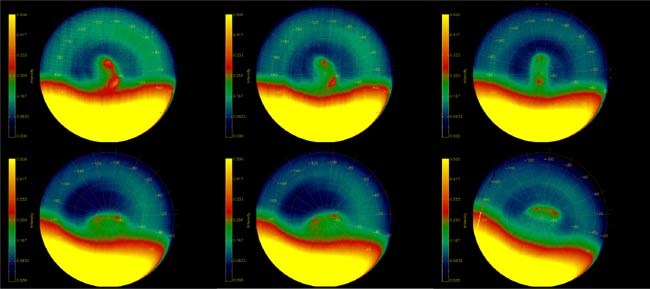
A huge "double-eye" atmospheric vortex has been confirmed to exist at the South Pole of the planet Venus.
The observation was made by the European Space Agency's Venus Express during its first orbit around the planet.
On April 11 of this year, Venus Express was pulled into its first elongated orbit by the planet's gravity. During this so-called "capture-orbit," the spacecraft circled Venus for nine days.
The spacecraft made infrared, visible and ultraviolet observations about the planet's atmosphere from varying heights, ranging from about 220,000 miles (350,000 km) to about 250,000 miles (400,000 km) above the surface.
One of the most striking observations was of a double-eyed atmospheric vortex over the south pole. A similar vortex at the planet's North Pole has been studied in detail before, but only glimpses of the south vortex have been made in the past. New images allow closer study of the phenomenon and allowed researchers to stitch together an animation.
Scientists think the vortexes are created by a combination of a natural cycling of hot air in the planet's atmosphere and high velocity, westward-blowing winds that take only four days circle the planet. It is still unclear, however, why there are two vortexes at each pole.
"We still know very little about the mechanisms by which super-rotation and the polar vortexes are linked," said Hakan Svedhem, ESA's Venus Express Project Scientist.
Get the Space.com Newsletter
Breaking space news, the latest updates on rocket launches, skywatching events and more!
"However, the mission is just at the beginning and it's doing fine," Svedhem said. "We expect this and many other long-standing mysteries to be addressed and possibly solved by Venus Express."
- Gallery: Postcards from Venus
- Gallery: Below the Clouds of Venus
- Europe's Venus Express Probe Gets New Launch Date
- Life Zone on Venus Possible
Join our Space Forums to keep talking space on the latest missions, night sky and more! And if you have a news tip, correction or comment, let us know at: community@space.com.
Ker Than is a science writer and children's book author who joined Space.com as a Staff Writer from 2005 to 2007. Ker covered astronomy and human spaceflight while at Space.com, including space shuttle launches, and has authored three science books for kids about earthquakes, stars and black holes. Ker's work has also appeared in National Geographic, Nature News, New Scientist and Sky & Telescope, among others. He earned a bachelor's degree in biology from UC Irvine and a master's degree in science journalism from New York University. Ker is currently the Director of Science Communications at Stanford University.









